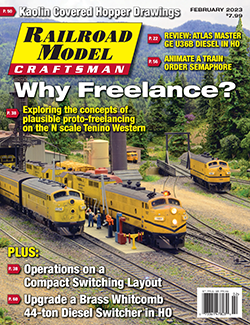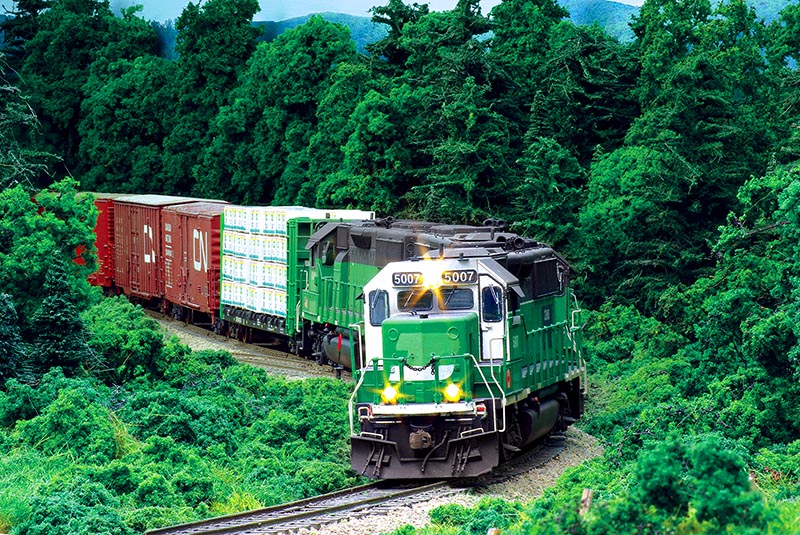 “Today’s railroading is boring. It’s all the same. nothing but wide-cab locomotives and endless container trains. Not nearly as interesting as what I remember growing up!”
“Today’s railroading is boring. It’s all the same. nothing but wide-cab locomotives and endless container trains. Not nearly as interesting as what I remember growing up!”
How many times have you heard people say something dismissive like this? Maybe you have even said it yourself! But is “modern” railroading actually boring? Are the trains of today less interesting than those of the past? Could it be interesting to model today’s current scene?
Before we can answer these questions we need to define what “modern” means. Some consider modern to be anything after 1970; I think we can agree that grouping the past 50 years under one banner is not practical. What about the period after the introduction of the contemporary wide-cab locomotive on American rails? That puts us around 1990, still not really modern.
I propose we consider shifting the modern era forward to anytime after the introduction of the General Electric Evolution series of locomotives, the EMD SD70ACe, and the FRA requirement for reflective (“conspicuity”) striping on the sides of freight cars. This all happened around 2005, nearly twenty years ago (yes, really). We could say “present-day” means the most recent five-year period after the introduction of Positive Train Control and the associated locomotive antennas and wayside signal changeovers.
Many modelers focus on locomotives and spotting the differences between models and even phases of the same model. A favorite of mine is the GMD GP40-2L and GP40-2W family produced between 1974 and 1978 for the Canadian market; you will find at least half a dozen on my layout. Each has been custom-built to represent a slight variation from the others. You know those “identical” wide-nose GEs? The detail, phase, and paint scheme differences are just as plentiful as the GP40-2s from a generation earlier. How about those well cars and containers you see today? They have just as much variation as the “standard” 40-foot boxcar of days past.
There is also a lot of manufacturer support for the modern-era modeler. Athearn, Atlas, Rapido, ScaleTrains, and Walthers have all released modern locomotives and freight cars, while Atlas and Rapido have also released modern commuter equipment. Smaller manufacturers are taking part, too. For example, MAC Rail is making locomotive antenna arrays, EOT devices, and other important details.
Modern does not mean excluding older stuff from your layout. Railroads often run through older parts of town populated by structures built many decades ago. Old stations (often repurposed) and towers (abandoned) still stand along the tracks. Warehouses, industries, and commercial structures of all ages can be prototypically modeled on a present-day layout. For modern structures, companies like Summit USA offer kits for recognizable chain restaurants and businesses found coast-to-coast. Modern modeling can still offer plenty of model building alongside ready-to-run products.
Speaking of model building, what other opportunities does the modern era offer? The second-hand locomotive market is very robust, meaning you can patch and renumber units for new owners or lease service. And don’t forget weathering. Alongside today’s newer equipment, you will find older cars with dirt and rust that reflect their age and commodities carried. Freight car weathering has almost become a hobby within a hobby! What about signals? The latest style of signal found along main lines everywhere is currently available from Atlas in HO already assembled and in eight different configurations! Kits are available from Showcase Miniatures for the N-scalers.
But what about space? If you don’t have room for a basement-sized layout to convey the scale of contemporary main line railroading, then consider a short line or switching operation. Older locomotives, a slower pace, and single-car customer switching are still the rule, alongside the details of modern railroading. Plus, short lines love to patch and renumber older equipment!
Perhaps the biggest advantage to modeling the modern era is the access we have to information. Acquiring prototype information and modeling ideas is as easy as going trackside and observing everything around you. For those inclined to spend time online, there are internet forums, Facebook groups, and photo sites devoted to railroad operations all over the world.
If you aren’t satisfied with your current modeling endeavors or are new to the hobby, why not consider modeling the modern era? Head trackside and see what is going on. You might find something interesting! —Andrew Castle



